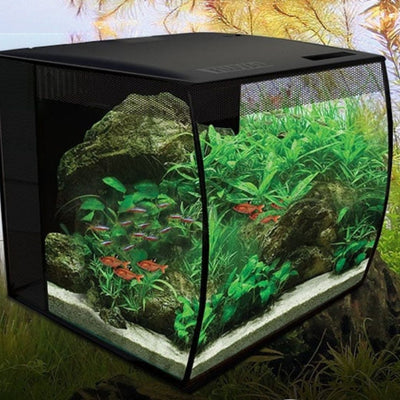A beautiful aquarium is a combination of fish and plants that are in balance. The healthy plant foliage provides the perfect backdrop for the fish to show off their natural beauty. However, if the balance between the fish and plants is out of sync, the tank can take on the appearance of a green murky mess. Controlling algae is all about controlling the inputs that you as the fish keeper put into the aquatic environment. Algae are just simple plants with the same requirements as any plant to thrive. These are nutrient, light and carbon dioxide.
Here are three easy steps to follow to help keep algae under control.
Step 1. Control the amount of light.
Aquarium plants require an artificial source of light to grow and fish in the aquarium will always look better when a light is present. If you have plants growing in your aquarium then eight hours is the maximum amount of light your aquarium should receive each day. Aquariums without plants need as little as 6 hours. Certain types of algae will thrive when the amount of light is greater than the recommended amounts. It is also important that the light you are using to illuminate your aquarium is specifically made for aquariums because the spectrum in these will show up best colours of your fish and also encourage the healthiest plant growth.
Step 2. Control the nutrient
There are several sources of nutrient that enter an aquarium which are nutrient in the tap water, waste from the fish and also uneaten fish food. It is important to feed the fish a good quality dry food and only as much as can be consumed in about 30 seconds to a minute. Feeding amounts greater than this will create excessive nutrient that will encourage algae growth. .
Regular water changes of 1/3 once a month or a ¼ every couple of weeks will reduce the build-up of nitrates and other nutrients that are produced by the biological activity in the aquarium.
It's best to use a gravel siphon when cleaning the aquarium as this will separate the waste and sludge from the gravel bed which can also feed algae. A regular dose of waste digesting bacteria will also aid in keeping the build-up nutrient in the aquarium low.
Step 3. Get the Plants growing
There is nothing like a little competition from aquarium plants to help keep the algae in check. Healthy thriving plants will compete for nutrient and slow algae growth. Remember to feed your aquarium plants with a source of carbon and iron based fertiliser so they can grow rapidly and soak that nutrient out of the water.
For further information, call in & see us in the store, or email us: admin@weknowpets.com.au
4/72-76 Station St Bowral NSW 2576
PH: 024862 1175
© weknowpets 2018





